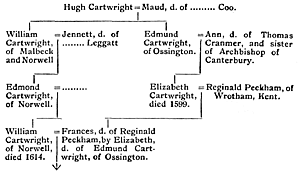The effigy of Reynald Peckham, on the dexter side of his lady, is twenty-four and a quarter inches in height, and he is represented in the complete armour of his time. This consists of pauldrons with pass-guards; the contes, with curiously formed and bow-like attachments; the tuilles, which are small, are attached to the cuirass; demi-placcates protect the cuirass; a skirt of mail; a sword which is worn diagonally from the sinister side; and a misericorde, which is straight on the dexter side. The hands are not protected or covered, but about the wrists are loose ruffles or cuffs. The head rests upon a helmet. The feet, which rest upon a couchant greyhound, are shod with quaint sabbatons.
The dame’s effigy is attired in an outer cloak with loose hanging sleeves, and an under dress, the sleeves of which are tight and embroidered; she wears a French head-dress with pearl borderings; round her waist is a tasselled girdle.
There are three shields on the west side of the tomb—one in the centre of each panel. They are of brass. The tinctures, inlaid in wax, may be thus described:—
1st Shield—Quarterly 1st and 4th, ermine, a chief quarterly, or and gules.—Peckham. 2nd and 3rd, gules, on a chevron argent, three talbots sable.—Burgoyne.
Impaling, Quarterly, 1st and 4th, argent, on a chevron azure, between three cranes sable, as many cinque-foils pierced, or.—Cranmer. 2nd and 3rd, argent, five fusils gules, each charged with an escallop, or.—Aslaclon.
2nd (or Centre) Shield.—Packham impaling Burgoyne.
3rd or Southern Shield.—Burgoyne.
An inscription in old English lettering runs round a chamfer on the ends and side of the altar tomb. On the north end only three words remain. They are “shall loke upon.” There is no inscription upon the east side of the tomb, which is built into the wall. The south strip has disappeared within the last few years. That on the west side has been confused in re-fixing. We give the legend, restored:—
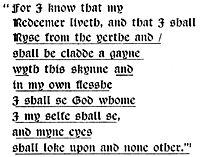
This inscription is from the book of Job, chapter xix., v.v. 25-27.
The question naturally arises, why should Reynald Peckham have been interred at Ossington, and not at Wrotham, which was his native place, and where four brasses exist to members of his family?1
A brass on the floor, near the Peckham tomb, bears this inscription:—
MARY PIERREPONT DAUGHTER TO
SR HENRY PIERREPONT OF HOLME PIERRE
PONT KT IN THE COUNTIE OF NOTTINGHA
AND WIFE TO FOULKE CARTWRIGHT OF
OSSINGTON ESQ: IN THE SAME COUNTIE
DIED THE EIGHTH DAY OF MARCH 1670.
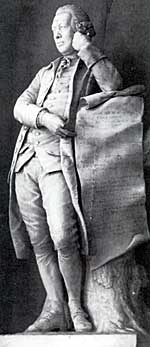
Statue of William Denison by Nollekens.
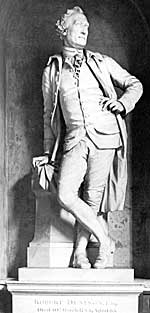
Statue of Robert Denison by Nollekens.
At the west end of the church are two marble statues, both by the hand of Nollekens, the sculptor. One represents William Denison, who was a great foreign merchant of Leeds, one of whose ships was the first to reach Lisbon with relief after the earthquake in 1755; he died in 1782, aged sixty-eight. It was this gentleman who purchased the manor of Ossington from the Cartwrights in 1753. He served as High Sheriff in 1779.
The other statue is that of Robert Denison, who succeeded his brother William in his estates in Notts., Yorks., Lincoln and Durham. He died in 1785, and was in turn succeeded by his sister’s son, John Wilkinson,who assumed the name and arms of Denison, and by his second wife became the father of John Evelyn Denison, Speaker of the House of Commons, created Viscount Ossington on his retirement from that post in 1872. Viscount Ossington died without issue in 1873, when his nephew, the present owner, succeeded to the estate.
After leaving the church, Mr. Denison showed the visitors round the grounds and the house, which is a modern mansion, the old house shown in the plate in Dr. Thoroton’s History (p. 358) having been pulled down some years ago. Mr. Denison is the owner of a unique library of works on angling, including, among many rare and valuable works, the celebrated “Boke of St. Albans,” by Juliana Berners, 1496, together with the original manuscript from which she wrote the fishing portion of the “Boke,” about 1452. This is the oldest known printed treatise on fishing. There is also a pamphlet on fowling and fishing, in Flemish, printed at Antwerp, in 1492, and the first four editions of Isaac Walton’s “Compleat Angler.” In the dining-room are portraits of John Wilkinson and Robert Denison, by Gainsborough; of William Denison, by Romney; and of the late Speaker, Lord Ossington, by Sir F. Grant.
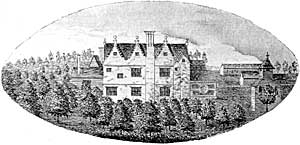
Ossington Hall in 1676.
(1) This query seems explainable thus: Edmund Cartwright, after the dissolution of the Monastries, had Mailing in Kent. His daughter Elizabeth, married Reginald Peckham, of Wrotham, Kent; Frances Peckham, the issue of this marriage, married back into the Cartwright family. Probably Reginald Peckham, died whilst in Notts., and was buried at Ossington.
